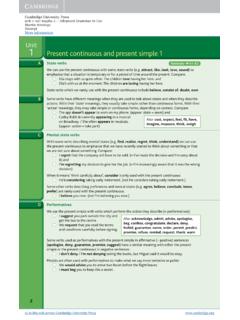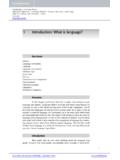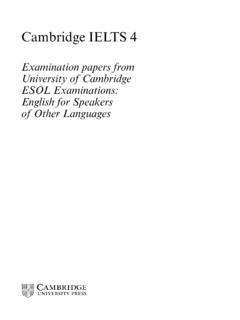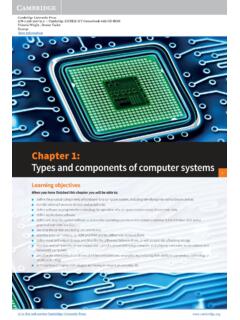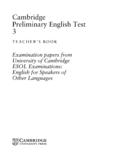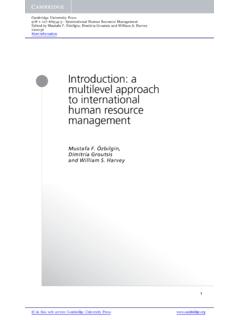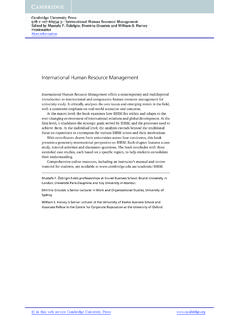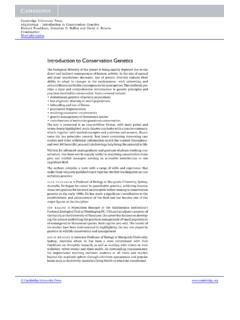Transcription of Unit 1 Characteristics and classification of living organisms
1 Cambridge University Press 978-0-521-68054-7 - NSSC Biology Module 1. Ngepathimo Kadhila Excerpt More information Unit 1. Characteristics and classi cation of living organisms Welcome to the exciting and amazing world of living things. Go outside and look around you. Look at the sky, the soil, trees, plants, people, animals. Nature is all around you if you have the eyes to see it. Count how many living things you can see. What is it that makes living things different from things that are not alive? Biology is the study of living things. It deals with what all living things can do, how they do it and why they do it.
2 In biology, there is always a relationship between the structure of an organism, its function, and its adaptation to its function or environment. Biology also tackles the important topics such as population, environmen- tal issues as well as health issues. In this course, you will learn to identify different kinds of living things and how to classify them. Most of the six activities in this unit will take you only ve to ten minutes to complete. This unit is divided into ve sections: A Characteristics of living organisms B Classi cation of living organisms C The hierarchical classi cation system D Binomial system of naming species E Simple dichotomous key When you have studied this unit, you should be able to.
3 List and describe the Characteristics of organisms de ne the terms nutrition, excretion, respiration, sensitivity, reproduction, growth and movement outline the use of a hierarchical classi cation system for living organisms classify living organisms into kingdoms, orders, classes, families, genera and species de ne and describe the binomial system of naming species construct dichotomous keys use simple dichotomous keys based on easily identi able features. Cambridge University Press Cambridge University Press 978-0-521-68054-7 - NSSC Biology Module 1. Ngepathimo Kadhila Excerpt More information 2 NSSC Biology A Characteristics of living organisms Activity 1 will help you think about what makes living things dif- ferent from non- living things.
4 ACTIVITY 1. This activity should take you about ve to ten minutes. What makes living things different from non- living things? Look at Figure 1. Look at the living and non- living things which you can see in the picture. Figure 1. Answer these questions in your notebook. 1 List three different living things which you can see in Figure 1. 2 List ve different non- living things which you can see in Figure 1. It is obvious that people are living things. Most of us realise that plants are living too, but what about a car? Cars need fuel, and can do many of the things that animals and plants can do. An individual living thing, such as an animal or a plant , is called an organism.
5 The term living organism' is usually used to describe something which displays all the Characteristics of living things. Cambridge University Press Cambridge University Press 978-0-521-68054-7 - NSSC Biology Module 1. Ngepathimo Kadhila Excerpt More information Module 1 Unit 1 3. Characteristics of living things There are seven activities which make organisms different from non- living things. These are the seven Characteristics of living organisms . 1 Nutrition living things take in materials from their surroundings that they use for growth or to provide energy. Nutrition is the process by which organisms obtain energy and raw materials from nutrients such as proteins, carbohydrates and fats .
6 2 Respiration Respiration is the release of energy from food substances in all living cells. living things break down food within their cells to release energy for carrying out the following processes. 3 Movement All living things move. It is very obvious that a leopard moves but what about the thorn tree it sits in? Plants too move in various different ways. The movement may be so slow that it is very dif cult to see. 4 Excretion All living things excrete. As a result of the many chemical reactions occurring in cells, they have to get rid of waste products which might poison the cells. Excretion is de ned as the removal of toxic materials, the waste products of metabolism and substances in excess from the body of an organism.
7 5 Growth Growth is seen in all living things. It involves using food to produce new cells. The permanent increase in cell number and size is called growth. 6 Reproduction All living organisms have the ability to produce offspring. 7 Sensitivity All living things are able to sense and respond to stimuli around them such as light, temperature, water, gravity and chemical substances. Learn these seven Characteristics of living organisms . They form the basis of the study of Biology. Each one of these Characteristics will be studied in detail during the course. Whilst many other things carry out one or more of the above processes, only living organisms possess all of these Characteristics .
8 ACTIVITY 2. This activity should take about ve minutes. A motor car needs petrol and air in order to move. It produces waste gases. a Which Characteristics of living organisms are similar to those of a motor car? b Why is a car not a living organism? Cambridge University Press Cambridge University Press 978-0-521-68054-7 - NSSC Biology Module 1. Ngepathimo Kadhila Excerpt More information 4 NSSC Biology ACTIVITY 3. Spend about ten minutes on this activity. 1 Some yeast, sugar and water are mixed in a test-tube. The diagrams show the test-tube at the start and after one hour. Figure 2. a Which process causes this change?
9 A growth B irritability C reproduction D respiration b Excretion, irritability and reproduction are Characteristics of: A all animals and plants B animals only C plants only D some animals and some plants only c Which one of the following functions is carried out by green plants but not by animals? A excretion B growth C photosynthesis D respiration d Figure 3 shows how sh react when the glass on one side of an aquarium tank is tapped with a nger. Figure 3. What Characteristics of living organisms does this demonstrate? A excretion and movement B excretion and nutrition C growth and irritability D irritability and movement 2 Complete the passage below by choosing the words from this list: excretion growth irritability movement nutrition organisms reproduction respiration A living things are often called _____.
10 B All living things release energy from their food in a process called _____, which happens inside their cells. Cambridge University Press Cambridge University Press 978-0-521-68054-7 - NSSC Biology Module 1. Ngepathimo Kadhila Excerpt More information Module 1 Unit 1 5. C Some of the energy is used for _____, which usually happens more quickly in animals than in plants. D The food from which the energy is released is taken into the body in a process called _____. E All living things get bigger as they get older. This process is called _____. F The production of young is called _____. G Waste substances are removed from organisms by the process of _____.

